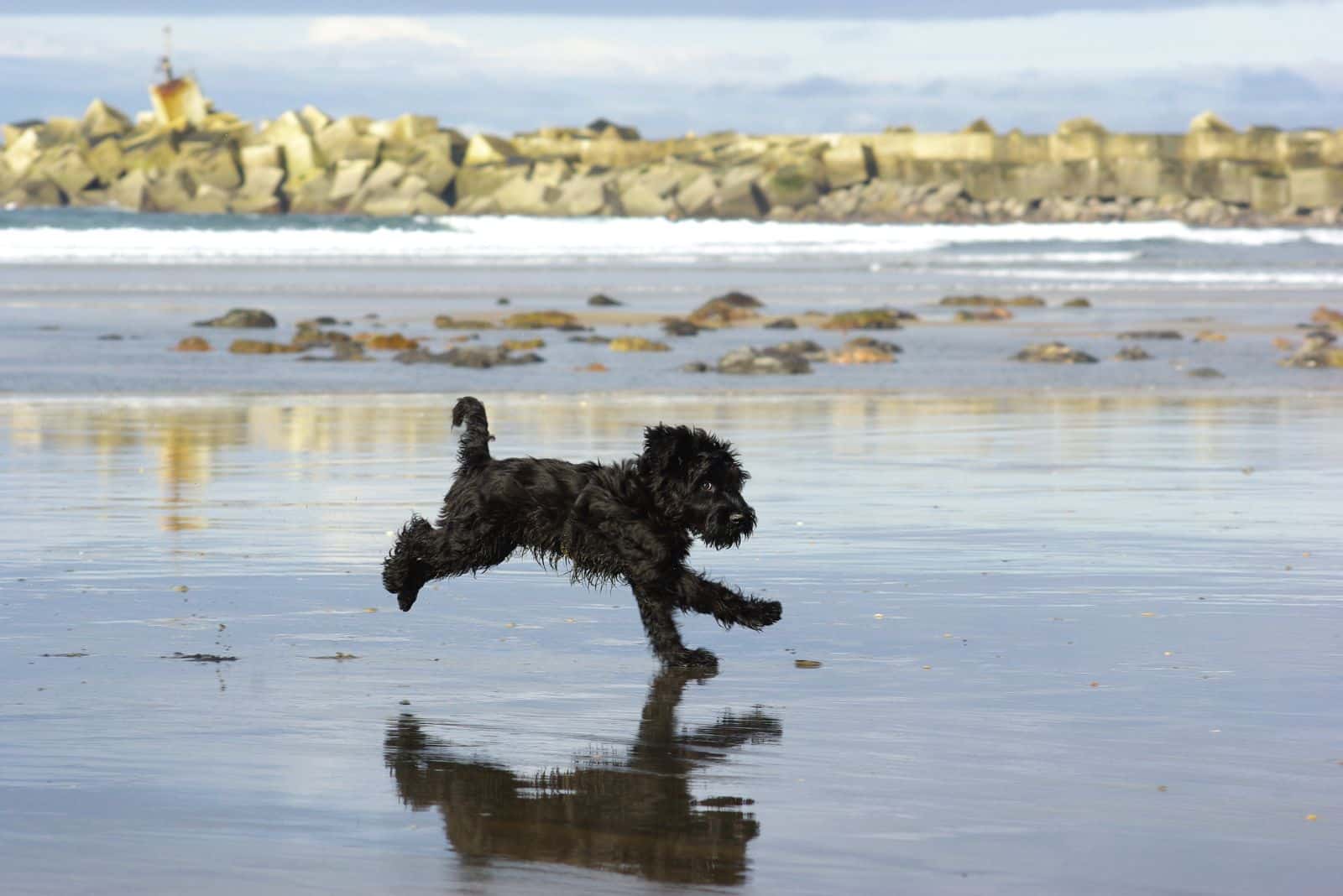The Schnauzer/Poodle hybrid, known as the Giant Schnoodle, is larger than the purebred parent breeds. All the benefits of the Schnoodle mix are present, but in a more substantial form.
This adorable dog is smart, beautiful, and has a well-regarded hypoallergenic coat. Large families will find it to be the ideal companion!
Stay tuned as we take a look at this giant pup if you’re seeking for something like a Schnauzer Poodle mix, which is larger and a little bit braver than the typical one.
You may read about its beauty, background, and anything else that falls into the basic description of this dog breed in the following passages!
What Is The Giant Schnoodle?
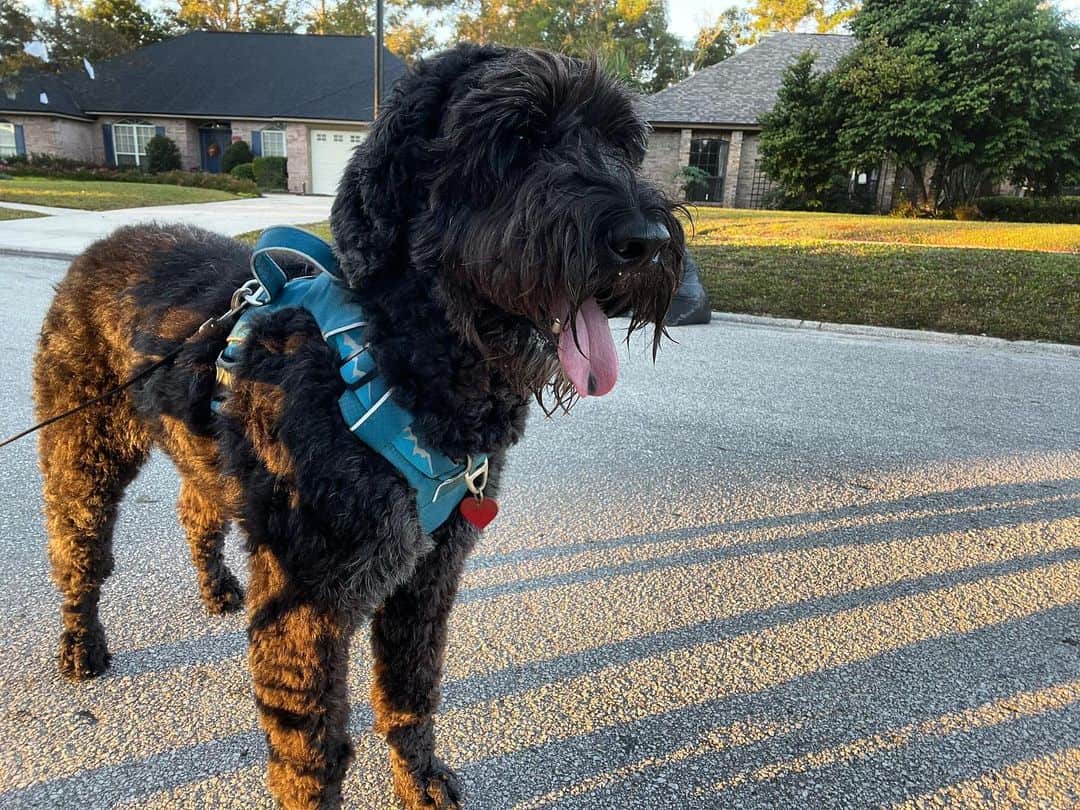
The Giant Schnoodle is a delightfully loyal and entertaining family dog who absolutely adores nothing more than to splurge the day hiking or having fun with its human pack, and then snuggling tightly on the couch at night.
The Schnauzerdoodle is among the big Poodle mixes that we just cannot get enough of.
Although he doesn’t like to bark, he is wary of strangers, and is willing to serve as a guard dog when he feels it’s required.
The Giant Schnoodle is known as a cross between whose parent breeds are the Standard Poodle and the Giant Schnauzer. It combines the watchful and adventurous nature of the Standard Poodle with both the daring, and protective character of the Giant Schnauzer.
Introducing The History Behind The Parent Breeds
Like many other designer dogs, the Giant Schnoodle’s past is a little murky. The one and only thing we can be certain of is that these dogs were initially created alongside other popular Poodle hybrids in the 1980s.
The Giant Schnoodle hybrid, and other Doodles, were first bred for their coveted hypoallergenic coat, which is a characteristic trait of the Poodle parent.
Our understanding of the Giant Schnoodle’s past is limited, but we are confident that its parent breeds have quite a distinguished past.
To begin with, the Schnauzer, as well as the Poodle, are both ancient breeds that have served as man’s closest companions for decades.
The Giant Schnauzer
The Giant Schnauzer must have been designed from the beginning to be a guard dog in the Bavarian Alps of Germany throughout the middle of the tenth century.
In actuality, Württemberg and Bavaria, two nearby kingdoms, are where all Schnauzers originated. In these agricultural lands, raising sheep, calves, and other animals has long been significant employment.
German farmers utilized these canines to guard their farms, even though they were bred to herd livestock from the ranch to the market.
The German word “Schnauze” translates to “muzzle” or “snout.” This phrase was used because the Giants’ whiskers and snout command immediate attention.
The Germanic peoples have been among the most productive races in creating new dog breeds. They not only displayed exceptional patience in evaluating ancestry, but they also demonstrated their capacity to produce the correct type.
One of the best instances of their breeding prowess is the Schnauzer – a dog that was produced in three different sizes in addition to being brought to magnificent physical shape and quick cerebral development.
Subsequently, the rough-haired sheepdogs as well as much later, the black Great Dane, crossed the road. Additionally, there is evidence to suggest that the Giant Schnauzer and the Bouvier Des Flandres (Flanders’ driving dog) are strongly connected.
The Poodle
Over the years, many Poodle breeds have been seen in Europe. Some of these are reproductions of the German painter, Albrecht Durer’s 15th and 16th century sketches.
Another illustration of a Poodle can be seen in Rembrandt’s 1631 self-portrait. The famed artist’s pet Poodle is visible in the portrait’s foreground.
It may be claimed that Poodles have historically always been pets of royalty and other affluent members of society because they play the roles of water Spaniels and Retrievers.
The most common breed of dogs in 18th-century Spain was the Poodle. The picture by Spanish painter Francisco Goya serves as proof. Before Goya was active, there is undeniable evidence that Poodles were present in Versailles.
France had toy Poodles during the time of Louis XVI. According to Louis’ documents, Filou was the name of the grandpa of Louis XVI’s Poodle. Sun King may have had Poodles as pets as well, according to the evidence.
Although Poodles have existed for generations in Europe, no one is certain of their exact origin. Despite the fact that they are regarded as a national breed in France, some people think they were actually born in Germany.
The Poodle, a descendant of the now-outdated French Water Dog, was bred to recover ducks for hunters. Its name possibly comes from the German ‘Pudel’, which means “plays in the water.”
Because of their intelligence and politeness, Poodles were appreciated and eventually utilized as companion animals as well as in circuses and dog exhibitions.
Of the three varieties of Poodles, the Standard Poodle is thought to be the earliest. Toy and miniature Poodles were probably crossed with the bigger Standard Poodles by breeders, although all three are judged under the same standards.
What Does The Giant Schnoodle Look Like?
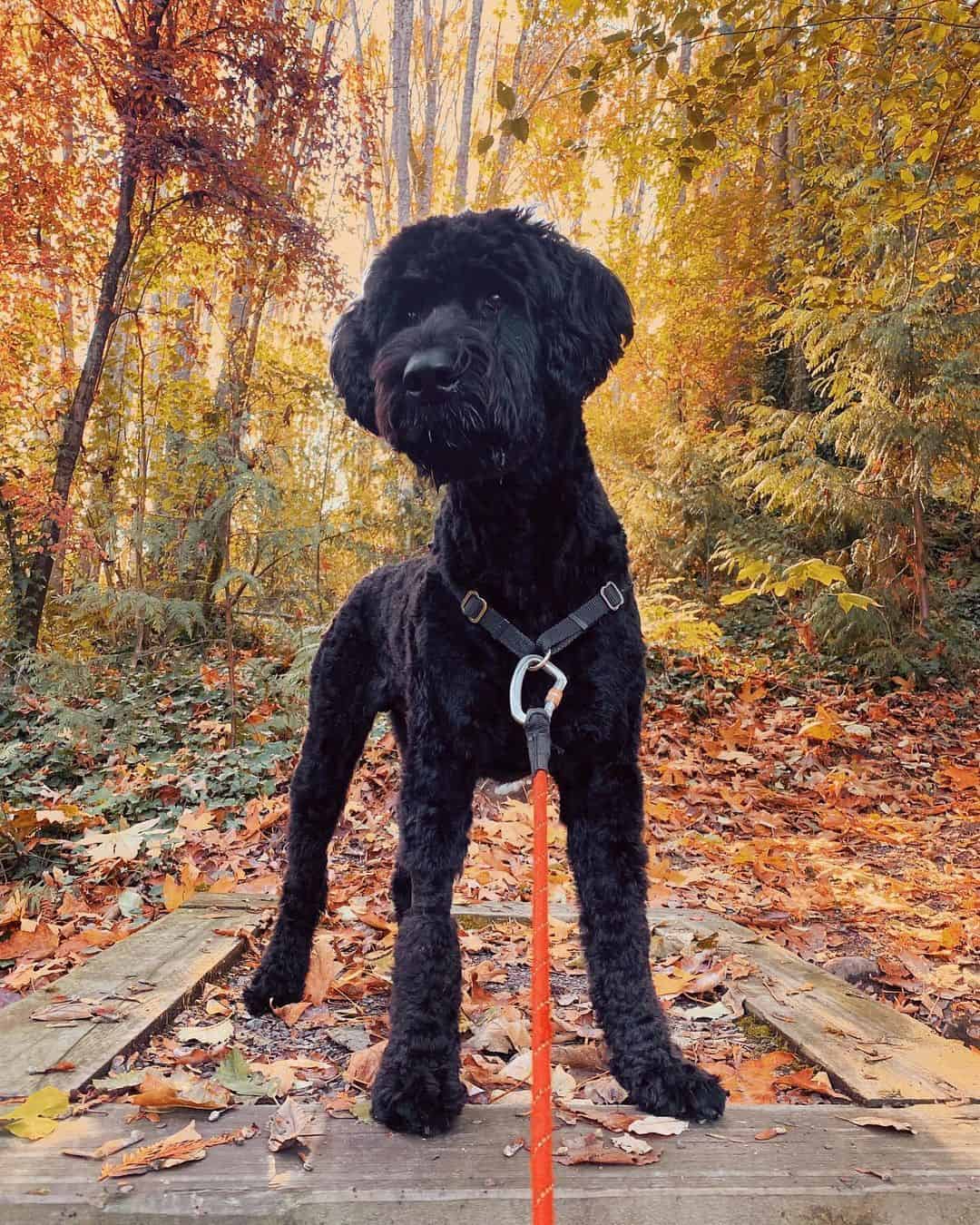
The Giant Schnoodle is an attractive canine that effortlessly attracts attention. The size of this puppy is comparable to that of a Giant Schnauzer and larger than the typical Standard Poodle.
The thick, wavy coat of the Giant Schnauzer Poodle cross comes in white, beige, silvery, black, as well as other Poodle coat colors. They typically have a smooth, silky coat that sits tightly to the body.
This hybrid’s body is proportionately built, and its walk is graceful, just like that of its parent breeds. It is neither overly muscular nor underweight.
Despite having slightly narrow legs, the Giant Schnoodle possesses quite large paws. They can have a straight tail or one that frequently curls upward.
The Poodle and Giant Schnauzer share some of the Giant Schnoodle‘s facial characteristics. This crossbreed can either take on the Poodle’s somewhat pointed nose or the Schnauzer’s boxy muzzle.
Fascinatingly, the Giant Schnoodle might have various ear forms. A few of these mixes are capable of developing folded ears like Schnauzers. Others may have long, floppy ears that resemble those of the Poodle.
The Giant Schnoodle is an all-around gorgeous dog. They are actually a more sophisticated variation of the adorable Schnoodle mix!
Even if I have already described the possible appearance of this mixed breed, I will go a step further to describe the parent breeds’ appearances so that you have a detailed overview of what your giant Schnoodle puppy may turn out to look like.
Giant Schnauzer Appearance
The Giant Schnauzer is a bigger, stronger form of the Standard Schnauzer, and according to the breed standard, it should “be quite a strong and courageous image of a dog.” His intellectual prowess and dedication make him a fantastic worker and friend.
The Standard Schnauzer and the well-bred Giant Schnauzer are very similar dogs. Giants are powerful, as their name implies.
A male could weigh 95 pounds, and have a height at the shoulders of 27.5 inches. The enthusiasts of the breed refer to their body as muscular, strong, and sturdy, yet athletic.
A rough beard and brows, emphasizing a keen, sagacious look, are familiar features of the Mini, Standard, and Giant. The double coating seems to be either pure black or “salt and pepper.”
The Poodle’s Appearance
The Poodle is one of the dog kingdom’s real aristocracy, regardless of whether it’s Standard, Miniature, or Toy, with either a black, white, or peach colored coat. Despite having a curly, low-allergen coat, it is a graceful athlete and reliable friend throughout its life.
There are three different sizes of Poodles: Miniature Poodles should be no larger than 15 inches at the shoulder, while standards should be no taller than 10 inches.
For all three varieties, the dimensions and bodily construction are the same. Inexpensive Continental clips are regularly seen on Poodles during dog shows.
A large percentage of pet owners favor the Sporting clipped style, which trims the coat to fit the contour of the dog’s strongly-sculpted body.
Irrespective of any preconceived notions you might have, Poodles are extremely adaptable, energetic, athletic, and clever dogs.
Due to his greater size and strength, the Standard seems to be the family’s best all-around athlete; however, other Poodles can simply be trained.
How Big Will My Giant Schnoodle Be?
A male Giant Schnoodle is frequently between 60 and 85 pounds, and between 25 and 28 inches tall.
On the other hand, a female Giant Schnoodle is between 22 and 25 inches tall, and weighs 55 to 75 pounds.
Like all dogs, the Giant Schnoodle‘s size is influenced by gender. Males are often slightly larger and heavier than females, usually by a few inches.
Using the measurements provided above, it is also reasonable to conclude that a Giant Schnoodle, when fully grown, is somewhat larger than a Standard Poodle, and roughly the same dimensions as a Giant Schnauzer.
Additionally, like the Poodle and the Giant Schnauzer, this large hybrid achieves its full Schnoodle size at about 18 to 24 months of age. Some species grow visibly more quickly than others, whereas others take a while to reach their peak size.
The Personality Of The Giant Schnoodle
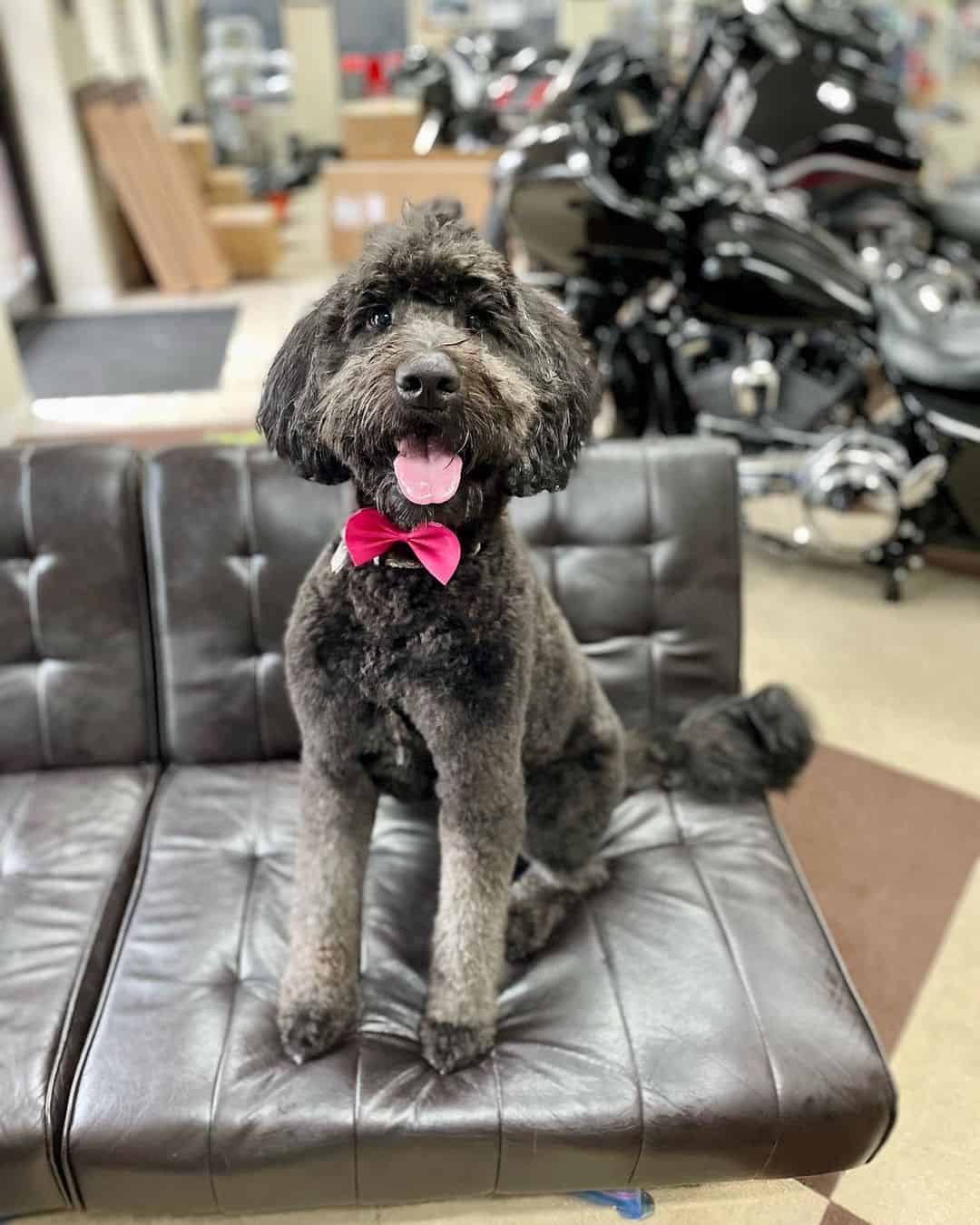
The Poodle as well as the Giant Schnauzer (the parent breeds of Giant Schnoodles) each contribute their greatest qualities.
This unique breed is a loving, intelligent, and incredibly entertaining dog! There are no documented behavioral problems with them.
The Giant Schnoodle seems to be a loving and friendly dog as well. This animal can understand social circumstances and easily make friends with new people. They thrive in a home with a large number of family members as well as other animals.
The Giant Schnoodle seems to be no pushover when training is concerned, either! This puppy picks up new skills quickly, especially if you begin training him at a young age.
However, because these hybrids can easily become exhausted, their endurance is not the finest.
Giant Schnoodles occasionally engage in mischief due to their inherent intellect. This dog can outwit its owner very quickly. Fortunately, as they become older, their stubbornness decreases.
The Giant Schnoodle thrives in a home with plenty of space for living. Even if they occasionally manage to get by in an apartment, they still require an area large enough for them to play and move around in.
The Giant Schnoodle Poodle mix might not be the greatest choice for you if you lead a hectic lifestyle. Since this puppy is likely to have separation anxiety, regular and early socialization is essential.
Giant Schnoodles are terrific family pets, all things considered. These puppies are therefore suggested to everyone, including first-time pet parents!
Lifespan Of The Giant Schnoodle
Mixed dog breeds are generally known to have a longer lifespan than the purebred parent breeds. However, that may not be the case with each and every mixed breed!
Approximately, the Giant Schnoodle’s lifespan can be anywhere between the ages of 13 years. Contrary to expectations, this designer breed has a marginally shorter lifespan than either the Poodle or the Giant Schnauzer.
For comparison, the life expectancy of its two parent breeds is 12 to 15 years.
This is very intriguing, particularly for a mixed dog breed that is meant to gain from the so-called hybrid improvement. But, why is that so? Does this imply that perhaps the Giant Schnoodle may be a dog breed with health issues?
Is The Giant Schnoodle A Healthy Dog Breed?
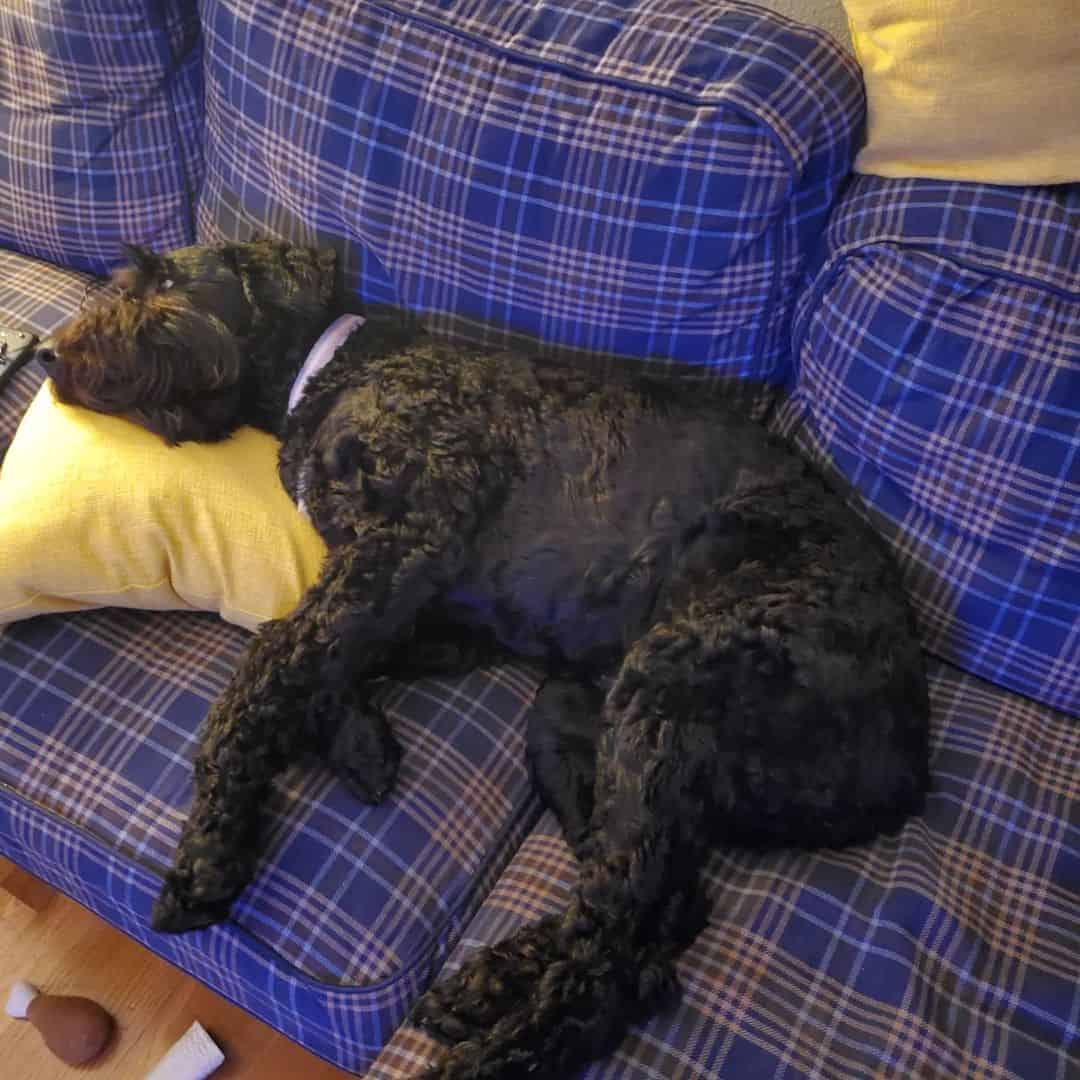
Designer dogs like Giant Schnoodles could have a number of health problems. Both parent breeds have significant rates of hip dysplasia, in particular.
Most breeders will examine the hips of the parents and the puppies; however, as soon as you bring it home, you should visit your young dog’s doctor to have an X-ray done on it.
Watch out for weight issues, cataracts, and cardiac problems as additional health issues.
In no way is the Giant Schnoodle mixture unhealthy. The Giant Schnoodle actually has a relatively good life span when contrasted with certain other large-breed dogs.
The longevity of this enormous hybrid, however, may be shortened by a few health problems.
Possible Health Problems Of A Giant Schnoodle
A comprehensive veterinarian exam for adult dogs should be performed at least once each year. When they reach about 4 months of age, puppies require vet checkups typically periodically, every 3 to 4 weeks.
Senior dogs (those over the age of 7 to 8 years) must visit the vet at least twice a year since older animals are more prone to illness.
In order to check for issues like early kidney and liver disease, your veterinarian may advise a health program for your dog that includes routine blood testing.
You should keep a close eye on your dog since you know it better than anybody else as a veterinarian might miss tiny symptoms of sickness.
In general, illness is characterized by a decrease of hunger or reduced activity. Other more specific symptoms include fluid from either the eye, ear, or nose, along with nausea, diarrhea, increased or decreased frequency of urination, struggling to breathe, and coughing.
Another symptom of illness is hair loss, along with itchy skin spots or ear-ringing. Lameness or stiffness, such as being unable to bear weight on a leg, are frequent symptoms of musculoskeletal injuries.
A visit to your veterinarian is advised if any of these symptoms persist in your dog for longer than one or two days.
You should also know of these possible health issues that your Giant Schnoodle may face:
1. Hip Dysplasia
The hip’s bone and cartilage start to deteriorate as the dog grows. This eventually results in arthritis, muscular atrophy, and decreased mobility.
Large-breed dogs are more frequently affected, and research indicates that it is inherited.
Hip dysplasia in dogs can cause long-term arthritis, although early detection of this condition can reduce or even prevent it from happening.
Canine hip dysplasia can be treated in a number of ways, along with a few surgical procedures and pharmaceutical management.
Before advising the best course of treatment for your dog, your doctor will take a number of variables into account. Prior to deciding whether surgery or medicinal management is best for your pet, a thorough orthopedic evaluation should be performed.
Before selecting a surgical procedure, there are numerous things to think about. Surgery often has a positive prognosis, and can help dogs function normally so they can live a regular life.
For advice on the best alternatives for your pet, see a board-certified surgeon or your primary healthcare veterinarian.
2. Cushing’s Disease
When the adrenal glands create too much cortisol (cortisone) in the dog’s body, Cushing’s disease (hyperadrenocorticism) develops.
A dog that has excessive cortisol may be at risk for kidney damage, diabetes, and other dangerous disorders and illnesses, which could be fatal.
Pituitary gland tumors, which can be benign or cancerous and are found in the pea-sized gland at the center of the brain, are a prevalent cause of Cushing’s disease in dogs. Rarely, the tumor may grow on the adrenal cortex, which is situated above the kidneys.
The continuous use of steroids results in increased cortisol production, which leads to Cushing’s syndrome.
Medications that aid in reducing the level of cortisone which the adrenals generate are frequently used as management for Cushing’s disease in canines.
The only option to treat Cushing’s disease is to eliminate the tumor, but because surgery is difficult and dangerous, the majority of patients are managed with medication.
3. Epilepsy
The brain illness known as epilepsy is defined by repeated seizures with no apparent cause, or changes in brain structure.
In other words, although the brain seems to work normally, it actually does not. An abrupt increase in the brain’s electrical activity, known as a seizure, results in symptoms like tingling, shivering, involuntary movements, twitches, and/or spasms.
Seizures can be focalized (only affecting a portion of the body; see the paper, “Focal Seizures & Fly-Biting in Dogs”) or generalized (affecting the entire body; see the handout, “Seizures in Dogs”).
The more frequent generalized epilepsy seizures are marked by shivering and intense shaking, stiffness of the shoulders and legs, slipping and falling down, poor bladder control, defecating, and making sounds.
The usual duration of a seizure is between 30 and 90 seconds, and the pet is usually unaffected throughout this time. Seizures can range anywhere from a second to a few minutes.
4. Cataracts
The retina, or the rear of the eye, is illuminated by light focused by a lens inside the eye. The retina is where vision happens.
The eye’s anatomy is comparable to that of a camera, which uses a lens to direct light onto a film. Cataracts are opaque or hazy lenses.
Inherited illness is the main reason for cataracts in dogs. Eye injuries and illnesses like diabetes mellitus are some more causes (“sugar diabetes”). Age is a factor in certain cataracts that seem to develop on their own.
They rarely result in reduced vision if cataracts cover just under 30% of the lens or if just one lens is impacted.
Visual impairment is frequently seen when the opacity reaches around 60% of the entire lens region. The dog will lose vision in the damaged eye if the opacity spreads to cover the entire lens.
The kind of cataract, the breed, as well as other associated factors will determine if the cataract advances or stays stationary.
5. Heart Issues
In dogs, cardiac disease has many different causes. Breed, nutrition, obesity, and aging are all potential risk factors. The most frequent ailment in small-breed dogs is heart valve disease, which often affects dogs five years of age or older.
No matter what type of cardiac issue your dog has, it’s critical to recognize the early warning symptoms. Since 95 percent of canine cardiac issues develop as they age, treating them as soon as they appear is easier.
Valve Illness
A cardiac murmur in dogs is frequently caused by a valve condition called mitral regurgitation. The murmur is caused by turbulent blood flow.
The murmur is more noticeable the higher the age, but with a cardiac murmur, your dog can still live a normal life.
A canine cardiologist with board certification can provide a diagnosis and offer treatment.
Heart Muscle Illness
Heart muscle illness most frequently manifests as dilated cardiomyopathy, or DCM. The muscles start to deteriorate with DCM.
Congestive heart failure results from that weakening because it reduces the heart’s contractual capacity to pump blood efficiently.
Although DCM in dogs cannot be reversed, it can be managed with drugs obtained from your board-certified canine cardiologist.
Maintaining A Giant Schnoodle
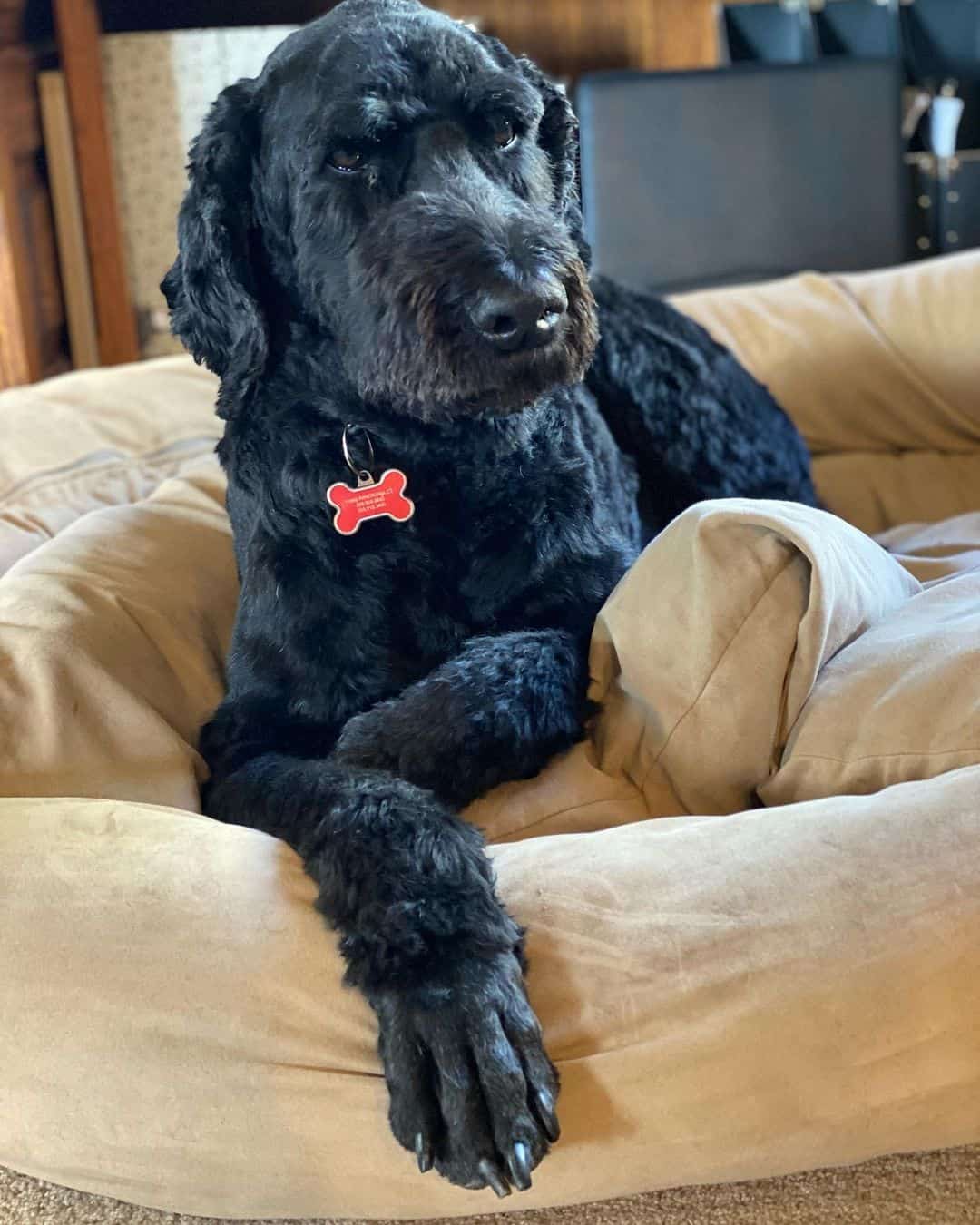
Pet lovers all around the world, from New Zealand to Spain, know that once you get a dog, you have to take care of it.
Our Schnauzerdoodle is not an exception. By being part Poodle, part Giant Schnauzer, this dog breed is considered as intelligent, yet of low maintenance.
Make sure that you have a great vet in your contacts list, a kennel or a dog bed for it to sleep on, and high quality dog food. Those are the basics, the rest – read below.
Exercise Needs
The Giant Schnoodle Poodle hybrid needs training and exercise. After all, these puppies are sharp-witted, energetic, and playful.
The excellent thing is that house training this dog is simple, and a trainer is usually not required! Luckily, they don’t have any behavioral issues, but what they do have is an increased level of trainability.
The Giant Schnoodle responds well to positive reinforcement. This training method uses rewards, compliments, and canine clickers to encourage your dog. For them, this method works best and is most pleasurable!
This large dog requires playtime with various people, which can add to its overall socialization. Bringing your dog around different kinds of social situations will definitely benefit your best friend.
Your dog requires at least an hour of vigorous physical activity each day for exercise. These dogs love to go swimming, play fetch, and interact with other canines.
You will be happy to hear that these dogs can be great service dogs. Not only that, but this giant Teddy bear likes to cuddle, and is generally low maintenance, and also, it is highly intelligent and empathetic!
Additionally, interactive dog toys are a wise investment because they will keep your dog occupied for a long time.
Feeding A Giant Schnoodle
The Giant Schnoodle has a diet fit for a giant, after all. This dog obviously eats a lot! The Giant Schnoodle is indeed a huge eater, though not nearly as much as breeds of dogs that are bigger and more active.
These puppies require premium high-quality dry dog food that meets their dietary requirements. A great substitute for a Giant Schnoodle’s food is a healthy home-cooked supper.
Read More: Miniature Schnauzer Feeding Chart And All There Is To It
Two daily feedings are sufficient in terms of frequency. Never engage in free feeding!
As a general rule, stick to fruits, vegetables, and white meat alongside their kibble. Additionally, probiotic supplements greatly facilitate their digestion.
Consulting a veterinarian is usually a smart option if you’re unsure about your dog’s diet.
Grooming Needs
Giant Schnoodles only require few baths because they are hypoallergenic. They do have minimal dander fallout since they are a low-shedding hypoallergenic dog breed which can be perfectly managed at home.
To avoid matting and tangling, you must brush this dog’s coat at least two times a week. It’s also preferable to visit the groomer each month.
With the Giant Schnoodle mix, dental hygiene is something that you should pay particular attention to. In the same vein, these dogs’ nails must be cut at least twice per month.
The Poodle Giant Schnauzer mix doesn’t require to be bathed frequently.
In actuality, bathing your dog too regularly harms both its skin and coat. Additionally, remember to occasionally wipe your dog’s ears to keep them clean.
Final Word
The noble Giant Schnauzer and the sharp-witted Poodle were crossed to create the dedicated Giant Schnoodle. This hybrid dog breed, which is big, usually has a happy demeanor, lots of intelligence, and is easygoing.
Both children and adults will love spending time cuddling with the Giant Schnoodle. It will also enjoy playing and participating in activities that require thought.
It has an independent character, which could make it stubborn during training, but it is an intelligent dog, and it can easily learn commands if you are consistent with them.
